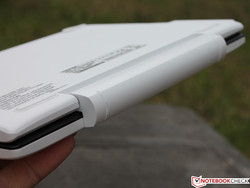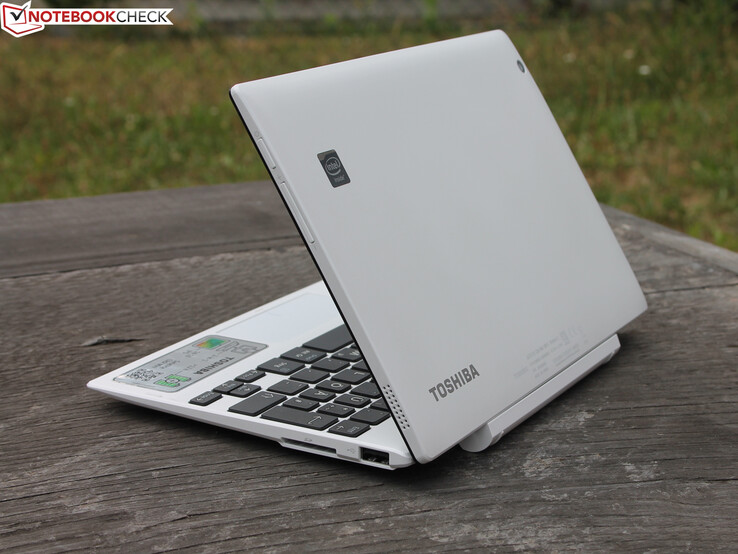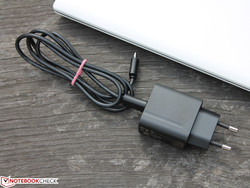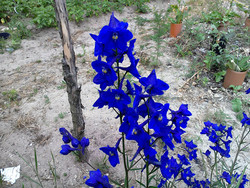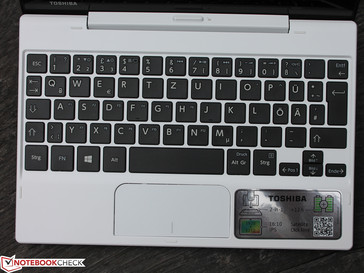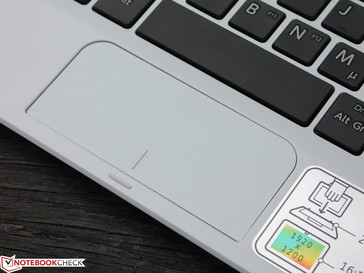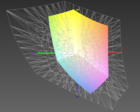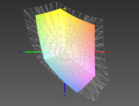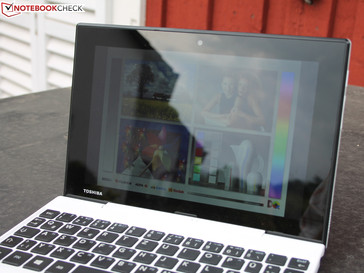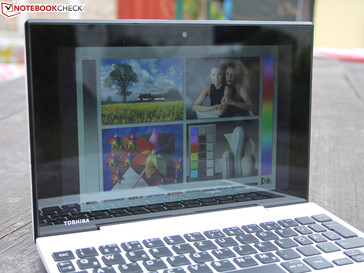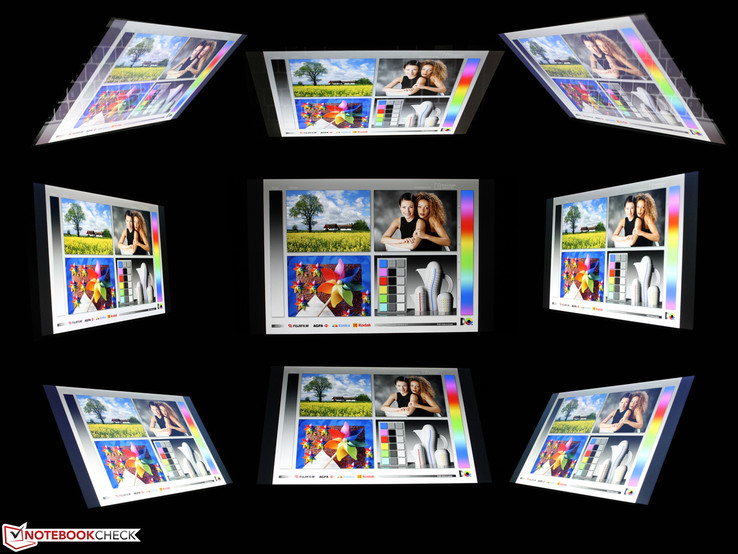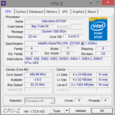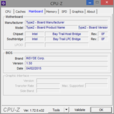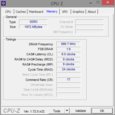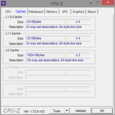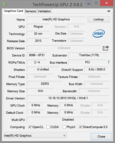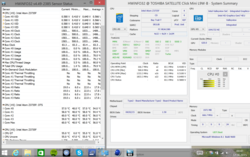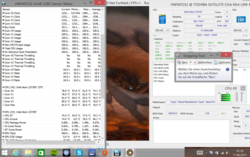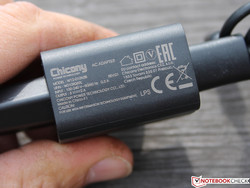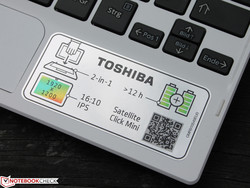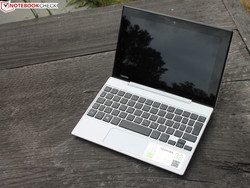Toshiba Satellite Click Mini L9W-B Convertible Review

For the original German review, see here.
There was a netbook boom from 2007-2011. An enduring, but slow mini notebook for an attractive price, which is what the consumer market and the Internet Everywhere wanted at the time, but by 2011, the hype was over. Now slowly but surely, this spot is being filled with tablets (also Android), which are the first choice as a mobile companion. Intel developed its netbook Atom chip (single-core: Pinetrail, dual-core: Cedar View) into multi-tasking optimized dual-core or quad-core chips (Clovertrail and Bay Trail T), respectively, to compete with the ARM-based rivals, but this only really started to work out with the second generation (Bay Trail).
With netbooks, users sacrificed an average entry-level notebook performance in favor of good mobility. Is this still the case today? The difference between a current Atom tablet and a current low-cost notebook (similar pricing, Bay Trail Pentium/Celeron) is comparatively low, so you do not have to sacrifice a lot of performance, as we will see in the Performance section. This is positive for all non-power users who do not want to live with a painfully slow system.
Currently there are plenty of options for those who are looking for a really small (maximum 10 inches) convertible with a keyboard dock. However, the selection is much more limited if you also want a decent resolution and Windows.
Acer's Aspire Switch 10 (10.1-inch, FHD, 335 Euros/~$370) and its more recent low-cost version, Switch 10E is a strong contender. Lenovo's Miix 3 10 (275 Euros/~$304) is also a 10.1-inch device with a docking solution. Its predecessor IdeaTab Miix 2 10 is also still available. The TrekStor SurfTab Wintron 10.1 3G (315 Euros/~$348) is a small exotic device since it is the only model with an integrated 3G modem for the truly mobile Internet access.
·Acer Aspire Switch 10 FHD 32GB + keyboard dock (335 Euros/~$370)
·Lenovo Miix 3 10, Atom Z3735F, 32GB (275 Euros/~$304)
·Lenovo IdeaTab Miix 2 10, Atom Z3740, 64 GB (330 Euros/~$364, discontinued)
·TrekStor SurfTab Wintron 10.1 3G Pro Tablet, 64 GB black (315 Euros/~$348)
Case
The tablet is made of smooth and white plastic. It feels conveniently smooth at the back, but not slippery. The surface is easy to clean and we cannot see any fingerprints. The construction is not overly torsion-resistant, and we can hear slight creaking when we try to twist it. Underneath the rear surface is a narrow hollow space, which is noticeable when you apply pressure. The TFT is integrated decoupled, so only a lot of pressure on the edges or the back will result in picture distortions.
The base is slightly more torsion-resistant and solid. The smooth surface and the working environment of the keyboard are made from the same plastic as the rear of the tablet. The bottom on the other hand is made of a matte, non-slip, but highly dirt-susceptible finish. The rough surface is quite tough to clean. Unfortunately, the rubber feet are white as well and you can see dirt residues.
The hinge sits very firm inside the base and two metal levers keep the tablet in position. The detachment is a mechanical process via pressure switch. The tablet connection is slightly wobbly and therefore bounces quite a lot when you use it. The maximum opening angle of the tablet is roughly 125 degrees, which is just sufficient for the use on the lap. Thanks to the battery inside the dock, the Click Mini has a very good center of gravity and the tablet is never at the risk of tilting over. The Click Mini will even tilt back to the front when we tilt the display by 20 degrees. Many tablets with docks have the problem of a keyboard unit that is too light, which results in a top-heavy stand.
Connectivity
Such a tablet does not have many ports, but Toshiba waives even the charging port in the Click Mini in favor of a USB 2.0 port. This Micro USB port can also be used to charge smartphones, which means the secondary battery can be a buffer battery for the survival of the smartphone. The battery in the dock can only be charged in combination with the tablet, because only the tablet has a USB port.
Two card readers – this is quite rare. You do not need an adaptor to read the standard SD-card of the camera in the dock. Small MicroSDXC cards can be read in the corresponding slot directly on the tablet. It can obviously also be used as storage extension for the internal storage, which is not very generous (memory cards up to 128 GB). You can only use around 8 GB of the 32 GB eMMC flash storage, the rest is used by the OS and tools. This was a real problem for the tests: Applications had to be deleted all the time.
Communication
We are impressed. The Wi-Fi module Realtek RTL8723BS (b/g/n) is basically nothing special, it only has one antenna (1x1 diversity) and only works in 2.4 GHz networks. Gigabit-AC-WLAN is therefore not possible. However, the Click Mini does something that we think is much more important: Maintain a stable connection beyond our 45 meters (~148 ft) measuring point. We even left the property by another 20 meters (~66 ft), but the device still showed 2-3 Windows bars. Although the speed was reduced, the connection did not drop and the Notebookcheck Wi-Fi script loaded without any problems. We have encountered such an excellent connection to the router only 2-3 times at the most in our long review history.
Accessories
Except for the power adaptor (10-watts), an ergonomics manual and a quick-start guide, there are no accessories in the box. In addition to Microsoft Windows 8.1 Bing (32-bit), you also get Microsoft Office 365 for one year. Attention! Both Toshiba and some shops list Windows 64-bit.
Warranty
Toshiba offers a 12-month warranty. It is an On-Site service in Germany and Austria after you have registered the repair at the Toshiba Notebook hotline. Other countries only get a Bring-In service (Europe, Middle East, Africa), which means you have to send in the device at your own cost.
Webcam
The rear camera takes decent pictures, especially in daylight or good artificial lighting conditions. It is easy to take a picture of a page from a book, but the autofocus has problems with moving objects and the sharpness is affected. Colors appear a bit too rich and details quickly become frayed. The performance is sufficient for eBay product pictures and chats, but we do not want to use it for pictures of our children during the holidays.
Input Devices
Keyboard
The keyboard for productive work – the great strength of the Click Mini? The keys have an average travel, but unfortunately no firm stroke, which applies to the whole area. The hollow stroke is accompanied by bouncing, which is a problem in the center in particular. The dock itself cannot be bent, but the keyboard just does not sit flush, so you have to live with annoying bouncing during typing.
All this is accompanied by an undefined pressure point, which results in a feedback that is too soft. The spacing is comparatively generous and you get a standard layout with Ctrl at the lower left and Del on the upper right. You have to get used to the keys F1-F12, because they can only be used as a secondary function in combination with the Fn key. This was pretty annoying when we wanted to use Delete (Fn + Del) since it is combined with Backspace.
The small arrow keys, including Page Up/Down (Fn+) do not extend into the palm rest. The narrow palm rest is especially problematic for larger hands and cannot provide good grip during typing. However, this problem is common amongst almost all 9 and 10-inch devices. Overall, the typing experience lacks feedback, the layout is useful, but not fully thought through (Del key).
Touchpad
The small mouse replacement has a smooth surface and the haptics differ from the palm rest. The fingers can easily glide across the ClickPad and there is not too much friction. Fingerprints or smudgy areas are no problem. It is a typical multi-touch ClickPad with zooming or scrolling features with two fingers, for instance.
The mouse button of the ClickPad is directly underneath the whole surface. Depending on the position of the fingers, the software recognizes a right or left click. The travel is very limited, and therefore, the pressure point is limited. The clicking sound is noticeable, but still comparatively quiet. The stroke is firm.
Touchscreen
The panel with 1920x1200 pixels can recognize up to 10 inputs simultaneously. It is sensitive up into the peripheral areas and the panel always executed our inputs quickly and reliably.
Display
The 8.9-inch touch panel (panel ID not readable, PVO) is based on the IPS technology and has a resolution of 1920x1200 pixels. This results in a pixel density of 254 PPI, an extremely fine resolution for an 8.9-inch device. A 15-inch laptop with FHD only manages 145 PPI. Individual pixels are not visible, not even when you are very close to the display.
The contrast ratio is 1479:1, a very good result. The brightness is constant on battery power, but the average luminance is only 205 cd/m². The brightness distribution between the nine measuring points is 89% and seems typical of a higher-quality tablet and notebook. A black display does not reveal any screen bleeding at the edges.
| |||||||||||||||||||||||||
Brightness Distribution: 89 %
Center on Battery: 207 cd/m²
Contrast: 1479:1 (Black: 0.14 cd/m²)
ΔE ColorChecker Calman: 7.98 | ∀{0.5-29.43 Ø4.77}
ΔE Greyscale Calman: 8.36 | ∀{0.09-98 Ø5}
64% sRGB (Argyll 1.6.3 3D)
41% AdobeRGB 1998 (Argyll 1.6.3 3D)
44.4% AdobeRGB 1998 (Argyll 3D)
64.4% sRGB (Argyll 3D)
42.94% Display P3 (Argyll 3D)
Gamma: 2.21
CCT: 7768 K
| Toshiba Satellite Click Mini L9W-B-102 HD Graphics (Bay Trail), Z3735F, 32 GB eMMC Flash | Acer Aspire Switch 10 SW5-012-13DP HD Graphics (Bay Trail), Z3735F, 32 GB eMMC Flash | Lenovo Miix 3 10 HD Graphics (Bay Trail), Z3735F, 32 GB eMMC Flash | Lenovo Miix 2 10 HD Graphics (Bay Trail), Z3740D, SanDisk U100 128 GB | Trekstor SurfTab Wintron 10.1 HD Graphics (Bay Trail), Z3735F, 32 GB eMMC Flash | |
|---|---|---|---|---|---|
| Display | 10% | 5% | 5% | ||
| Display P3 Coverage (%) | 42.94 | 47.57 11% | 45.21 5% | 44.94 5% | |
| sRGB Coverage (%) | 64.4 | 70.2 9% | 66.1 3% | 67.3 5% | |
| AdobeRGB 1998 Coverage (%) | 44.4 | 49.24 11% | 46.96 6% | 46.43 5% | |
| Screen | -6% | -5% | -31% | -6% | |
| Brightness middle (cd/m²) | 207 | 435 110% | 231 12% | 385.8 86% | 294 42% |
| Brightness (cd/m²) | 205 | 407 99% | 210 2% | 371 81% | 293 43% |
| Brightness Distribution (%) | 89 | 90 1% | 85 -4% | 87 -2% | 86 -3% |
| Black Level * (cd/m²) | 0.14 | 0.56 -300% | 0.22 -57% | 0.749 -435% | 0.35 -150% |
| Contrast (:1) | 1479 | 777 -47% | 1050 -29% | 515 -65% | 840 -43% |
| Colorchecker dE 2000 * | 7.98 | 5.12 36% | 5.76 28% | 5.19 35% | 5.52 31% |
| Greyscale dE 2000 * | 8.36 | 4.81 42% | 7.54 10% | 4.45 47% | 6.3 25% |
| Gamma | 2.21 100% | 2.38 92% | 2.44 90% | 2 110% | 2.54 87% |
| CCT | 7768 84% | 6723 97% | 7808 83% | 6674 97% | 7928 82% |
| Color Space (Percent of AdobeRGB 1998) (%) | 41 | 45 10% | 43 5% | 43 5% | |
| Color Space (Percent of sRGB) (%) | 64 | ||||
| Total Average (Program / Settings) | 2% /
-2% | -5% /
-5% | -13% /
-21% | -1% /
-3% |
* ... smaller is better
Subjectively, the display convinces with a rich black and vibrant colors. The black value at the highest brightness setting is excellent at 0.14. The competition cannot compete with this result (see table). The low luminance has a very positive effect on the black value, but the rivals can score with higher brightness values. The highlight is the Aspire Switch 10 SW5 at 435 cd/m². The ambient light sensor was deactivated for our measurements.
Our review unit covers 64% of the sRGB color space, but just 41% of the AdobeRGB color space, which means that the display is not suitable for professional graphics and picture editors. The DeltaE is also very high at 8, which suggests an inaccurate presentation of the sRGB colors. The competition, however, is not much better either and manages around the same AdobeRGB coverage. All comparison devices stay above the DeltaE limit of three.
The color deviations are especially high for magenta and blue, and we can see a color cast in these directions in the grayscale. These are the results with the factory settings, a calibration could slightly improve the color presentation. Our color profile is provided below.
You cannot really use the Click Mini in the outdoors because of the low brightness. 205 cd/m² combined with a glossy touch panel are not sufficient by any means. Bright daylight and sunshine make it impossible to see the display content. Its use in the outdoors would still be impossible even with an anti-reflective coating.
Performance
With an Intel Atom Z3735F (4x 1.33 GHz), 2 GB of RAM and 32 GB of flash storage (eMMC), the Click Mini is primarily designed for simple tasks on the road. Look at some camera pictures, browse the web, write mails in MS Outlook or edit Word and PowerPoint files – the Click Mini is powerful enough for such tasks. The Intel HD Graphics GPU integrated into the SoC is very frugal, and usually only supports the processor when you decode videos.
Processor
We have already reviewed the Intel Atom Z3735F a few times. It is a real mainstream model, which is used in the Lenovo Miix 3 8 or the Dell Venue 10 Pro 5055, for example. Different cases or cooling solutions can lead to better or worse benchmark results, depending on the utilization of the Turbo Boost (up to 1.83 GHz).
We therefore compare the review unit with the Switch 10, Miix 3 10 and SurfTab Wintron that use the same SoC. The Switch 10 falls behind (-17% Cinebench Multi) in the Multi and the Single test. We can only run the 32-bit version of Cinebench R10 because of the 32-bit OS, but we have a lot of results for this benchmark in our database. The scores are identical on battery and mains, and the benchmarks are both executed with roughly 1.58 GHz.
System Performance
The application performance of tablets with Intel Atom processors (Bay Trail T) is usually very similar. All systems are equally slow, but they can compete with low-cost laptops: The Acer Aspire E15 ES1-512 (Bay Trail) uses a Pentium N3540 and has a normal HDD. This 15-inch device is either worse or similar to Atom tablets in PCMark 7. You will need a Core i3 from the Broadwell generation for a better advantage. The ThinkPad Edge E550 is up to 230% faster in the PCMarks.
However, potential buyers do not have to worry about a slow Windows Convertible, because the Click Mini is usually sufficiently fast. You can expect waiting times only when you copy large files or execute CPU-demanding applications.
| PCMark 7 Score | 2335 points | |
| PCMark 8 Home Score Accelerated v2 | 911 points | |
| PCMark 8 Work Score Accelerated v2 | 1008 points | |
Help | ||
Storage Devices
SSDs usually have a very important role in the PCMarks, which we use to test the application performance; PCMark 7 in particular benefits from fast flash storage. However, just like all the other rivals, the Click Mini does not use an SSD, but a low-cost eMMC module. Those chips have better 4K-Read results than conventional hard drives, but they are not better in terms of the sequential transfer rates. There are small differences between the eMMCs, which is apparent when you look at the Switch 10 and the Miix 3 10. These two devices are 43% and 34% faster, respectively, than the Click Mini. However, this advantage was only visible in the PCMark 8 Home score (+13%) in the section above.
| Toshiba Satellite Click Mini L9W-B-102 HD Graphics (Bay Trail), Z3735F, 32 GB eMMC Flash | Acer Aspire Switch 10 SW5-012-13DP HD Graphics (Bay Trail), Z3735F, 32 GB eMMC Flash | Lenovo Miix 3 10 HD Graphics (Bay Trail), Z3735F, 32 GB eMMC Flash | Lenovo Miix 2 10 HD Graphics (Bay Trail), Z3740D, SanDisk U100 128 GB | Trekstor SurfTab Wintron 10.1 HD Graphics (Bay Trail), Z3735F, 32 GB eMMC Flash | |
|---|---|---|---|---|---|
| CrystalDiskMark 3.0 | 43% | 34% | -38% | -28% | |
| Read Seq (MB/s) | 90.1 | 169.3 88% | 81.8 -9% | 75.4 -16% | 102.1 13% |
| Write Seq (MB/s) | 44.71 | 72.8 63% | 52.7 18% | 31.83 -29% | 38.26 -14% |
| Read 512 (MB/s) | 86.1 | 151.1 75% | 86.1 0% | 69.3 -20% | 91 6% |
| Write 512 (MB/s) | 38.17 | 72.7 90% | 52.3 37% | 19.8 -48% | 19.43 -49% |
| Read 4k (MB/s) | 9.12 | 18.31 101% | 12.7 39% | 7.856 -14% | 9.034 -1% |
| Write 4k (MB/s) | 10.26 | 5.603 -45% | 13.65 33% | 3.639 -65% | 4.297 -58% |
| Read 4k QD32 (MB/s) | 20.82 | 26.66 28% | 50.2 141% | 11.89 -43% | 9.404 -55% |
| Write 4k QD32 (MB/s) | 13.5 | 5.642 -58% | 14.72 9% | 4.585 -66% | 4.286 -68% |
Graphics
The integrated HD Graphics (Bay Trail) is not powerful enough for games, but games from the Windows Store should run without any problems. Even very old games like “Risen” from 2009 only run in the lowest resolution, but not smoothly.
| 3DMark - 1920x1080 Fire Strike Physics (sort by value) | |
| Toshiba Satellite Click Mini L9W-B-102 | |
| 3DMark 11 - 1280x720 Performance (sort by value) | |
| Toshiba Satellite Click Mini L9W-B-102 | |
| Acer Aspire Switch 10 SW5-012-13DP | |
| Lenovo Miix 3 10 | |
| Lenovo Miix 2 10 | |
| Trekstor SurfTab Wintron 10.1 | |
| 3DMark 11 Performance | 210 points | |
| 3DMark Ice Storm Standard Score | 14495 points | |
| 3DMark Cloud Gate Standard Score | 1156 points | |
Help | ||
Emissions
System Noise
There is no system noise, because the tablet was designed without a fan.
Temperature
The Click Mini does not even get lukewarm while idling on the left rear, unless the battery is being charged when we can measured up to 40 degrees Celsius (~104 degrees Fahrenheit). Under sustained load, the temperatures are higher compared to the rivals, which is an indicator for the good Turbo utilization. The Switch 10 with lower CPU benchmark results, for example, stays cooler than the review unit. However, all the comparison devices are quite close in terms of the temperatures.
The stress test is executed at 1.33 GHz and 77 up to 80 degrees Celsius (~171 to 176 degrees Fahrenheit) at the SoC by our Click 10. The power consumption is at 10.6 watts in this case, which seems to be too much for the 10-Watt PSU and the battery is slowly discharging during the stress test. The secondary battery inside the dock still had a remaining capacity of 76% after 5 hours with Prime95 + FurMark. For comparison: The charging of the battery dock (when the tablet is off) requires 9.7 watts. This means that there is no headroom for the power consumption, but users do not have to worry about a discharging battery. Our stress test is an impractical scenario. A bigger issue is the long charging times when the device is turned on (see Power Consumption).
| Toshiba Satellite Click Mini L9W-B-102 HD Graphics (Bay Trail), Z3735F, 32 GB eMMC Flash | Acer Aspire Switch 10 SW5-012-13DP HD Graphics (Bay Trail), Z3735F, 32 GB eMMC Flash | Lenovo Miix 3 10 HD Graphics (Bay Trail), Z3735F, 32 GB eMMC Flash | Lenovo Miix 2 10 HD Graphics (Bay Trail), Z3740D, SanDisk U100 128 GB | Trekstor SurfTab Wintron 10.1 HD Graphics (Bay Trail), Z3735F, 32 GB eMMC Flash | |
|---|---|---|---|---|---|
| Heat | 11% | 3% | 3% | -9% | |
| Maximum Upper Side * (°C) | 47.6 | 44 8% | 38.1 20% | 43.4 9% | 47.1 1% |
| Maximum Bottom * (°C) | 47.6 | 38.1 20% | 50.6 -6% | 42.4 11% | 55 -16% |
| Idle Upper Side * (°C) | 35 | 33.1 5% | 36.2 -3% | 36 -3% | 35.4 -1% |
| Idle Bottom * (°C) | 32.4 | 29.1 10% | 32.1 1% | 33.8 -4% | 38.4 -19% |
* ... smaller is better
(-) The maximum temperature on the upper side is 47.6 °C / 118 F, compared to the average of 35.4 °C / 96 F, ranging from 19.6 to 60 °C for the class Convertible.
(-) The bottom heats up to a maximum of 47.6 °C / 118 F, compared to the average of 36.8 °C / 98 F
(+) In idle usage, the average temperature for the upper side is 30.9 °C / 88 F, compared to the device average of 30.3 °C / 87 F.
(-) The palmrests and touchpad can get very hot to the touch with a maximum of 40.4 °C / 104.7 F.
(-) The average temperature of the palmrest area of similar devices was 27.9 °C / 82.2 F (-12.5 °C / -22.5 F).
Speakers
The speakers are located at the right and left side of the tablet. The volume is okay, and we cannot hear distortions at the highest setting, but the sound is focused on medium tones and quickly leaves a negative impression. Dolby Digital Plus, an App with equalizer and manual presets for Game, Music, Voice and Movie, cannot work wonders, either. The sound is very thin and inconvenient in the long run.
The integrated microphone (next to the webcam) cannot impress us, either. The recordings suffer from a constant electric humming. This does not drown out the voice, but is still annoying. The result is more or less equally clear, it does not matter if you are sitting 50 cm (~1.6 ft) or two meters (~6.5 ft) away.
Energy Management
Power Consumption
Many current tablets use a smart power supply via USB port, which can also be an advantage for the user, at least if you do not need this port during charging. The device can be charged at any USB 3.0 port, and even the smartphone can be charged at the PSU of the Click Mini. What sounds like a nice homogenization of the power adaptors (vision: one power adaptor for many devices) also has a big drawback: The Click Mini needs 15 hours for a full charge of both batteries (while idling!).
We activated the Wi-Fi-Test during the charging, which simulates web browsing for many hours. Such light workloads, but at full brightness, already need 5-10 watts, so there is not much power left for the charging of the batteries and certainly not for the simultaneous charging of both batteries. By the way, the tablet battery is always charged first, but the dock module is discharged first, followed by the tablet.
| Toshiba Satellite Click Mini L9W-B-102 HD Graphics (Bay Trail), Z3735F, 32 GB eMMC Flash | Acer Aspire Switch 10 SW5-012-13DP HD Graphics (Bay Trail), Z3735F, 32 GB eMMC Flash | Lenovo Miix 3 10 HD Graphics (Bay Trail), Z3735F, 32 GB eMMC Flash | Trekstor SurfTab Wintron 10.1 HD Graphics (Bay Trail), Z3735F, 32 GB eMMC Flash | |
|---|---|---|---|---|
| Power Consumption | -19% | -22% | -12% | |
| Idle Minimum * (Watt) | 1.8 | 2.2 -22% | 2 -11% | 1.5 17% |
| Idle Average * (Watt) | 3.2 | 5.1 -59% | 5 -56% | 4.9 -53% |
| Idle Maximum * (Watt) | 4.4 | 5.5 -25% | 5.6 -27% | 5 -14% |
| Load Average * (Watt) | 10.8 | 9.2 15% | 11.4 -6% | 9 17% |
| Load Maximum * (Watt) | 10.6 | 10.8 -2% | 11.4 -8% | 13.4 -26% |
* ... smaller is better
| Off / Standby | |
| Idle | |
| Load |
|
Key:
min: | |
Battery Runtime
The Satellite should be well suited for long battery runtimes with a total capacity of 39 Wh, equally divided between the tablet and the keyboard dock, making it suitable for long durations. We reduce the brightness in the Wi-Fi-Test by six steps (very fine regulation) to 137 cd/m² (closest setting to 150 cd/m²), and a script simulates the browser usage.
Pros
Cons
Verdict
Web browsing for 10 hours, not bad for an 8.9-inch device with a price of just 300 Euros (~$331). The Toshiba Satellite Click Mini L9W-B-102 uses a keyboard dock with a secondary battery. The two modules have a charging time of 15 hours because of the weak power adaptor (device turned on). This is clearly an issue of the concept with a universal USB power adaptor. Once charged, you can expect a very good runtime of 10 hours when you browse the web.
Toshiba checks almost all the right boxes for the display: Very high contrast, reasonable color accuracy and a very high resolution, so you cannot see individual pixels. Unfortunately, the luminance does not seem to have been very important during the design process – 205 cd/m² are excessively low for the use in the outdoors.
The availability of the keyboard dock with USB type A and a standard SD card reader are big advantages. Unfortunately, the feedback of the keyboard is not very good, the typing experience is spongy and the small keys clatter as well.
The build quality of the reasonably sturdy device is okay, the author really liked the center of gravity on the lap or the table. Finally, the Satellite Click Mini convinces with a high and especially stable WLAN connection at more than 45 meters (~148 ft). Such a distance to the router is rare amongst all our notebook and tablet reviews.
The Satellite Click Mini 9W is a good choice for users who want a device for a long car or train ride at night. Movies are a joy with the high-contrast display, and the available networks can be used very reliably. If you want a better keyboard, you should have a closer look at the Lenovo Miix 3 10. The input of the Aspire Switch 10 Full-HD had similar issues to the Click Mini in our review.
Toshiba Satellite Click Mini L9W-B-102
- 07/02/2015 v4 (old)
Sebastian Jentsch


